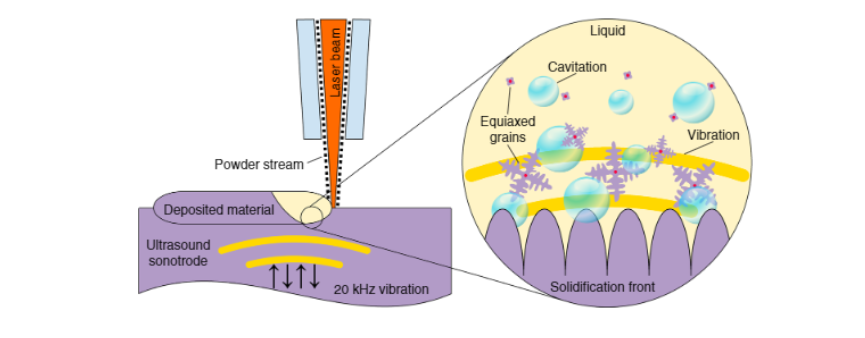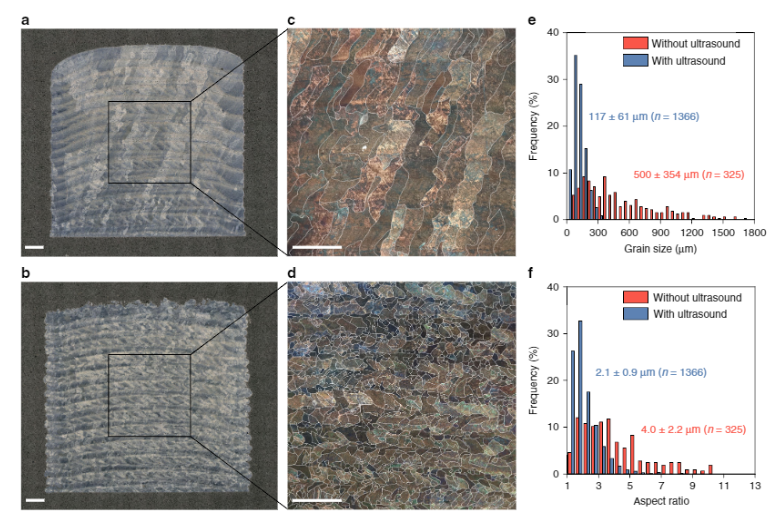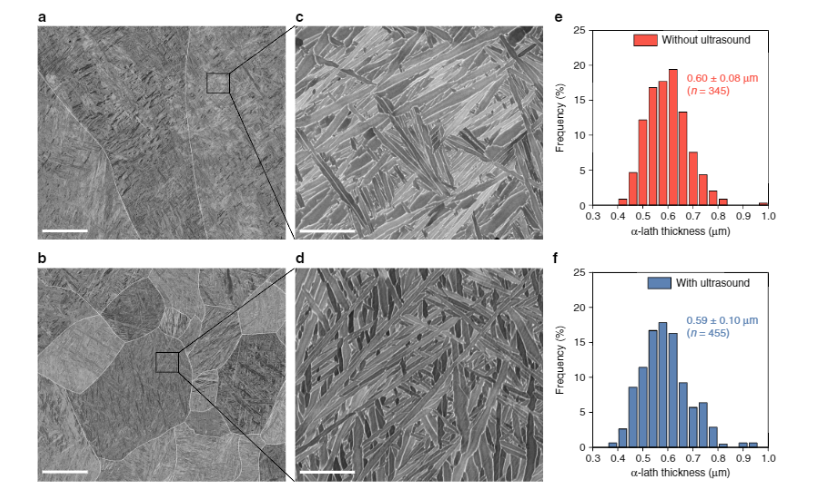As 3D printing in metal continues to lead the next industrial revolution, engineers from Australia are taking research one step further in examining improved methods for improving mechanical properties. Choosing a titanium alloy to create samples for experimentation and testing, the authors outlined their findings in the recently published ‘Grain structure control during metal 3D printing by high-intensity ultrasound.’
Samples consisted of 10 mm × 10 mm × 10 mm cubes for microstructural examination and 24 mm × 8 mm × 10 mm (length, width, and height) blocks for tensile testing. Without transforming the alloy at all, the researchers employ an additive manufacturing solidification-control solution to print metallic alloys with equiaxed grain structures, to prevent property anisotropy and the consequent decrease in mechanical performance. In this study, titanium alloy Ti-6Al-4V is used.
Reigning as the ‘benchmark alloy’ of titanium, and the subject of many studies, titanium alloy Ti-6Al-4V is used as a comparison for quality in metal AM processes.
“However, Ti-6Al-4V fabricated by different fusion-based AM processes exhibits a strong columnar grain structure. The columnar prior-β grains in AM-fabricated Ti-6Al-4V feature the strong <001> orientation along the build direction. This gives rise to a β → α transformation texture, which is an important concern for AM qualification because of the resulting anisotropy of mechanical properties,” explain the researchers.
“In addition, the coarse columnar prior-β grains may further degrade the strength of Ti-6Al-4V according to the Hall–Petch relationship established for lamellar α–β Ti-6Al-4V21–23 (exceptions can exist).”

High-intensity ultrasound during metal AM. Cross-sectional schematic showing metal AM by laser-based DED onto an ultrasound sonotrode vibrated at 20 kHz. The formation of acoustic cavitation and streaming in the liquid metal by high-intensity ultrasound can vigorously agitate the melt during solidification, thereby promoting significant structural modification or refinement.
While it can be difficult in metal 3D printing to find a strong and stable nucleant alloy, Ti-6Al-4V is exactly that.

a, b Optical microscopy images of the samples without (a) and with (b) ultrasound. c, d Polarized light microscopy images showing large columnar grains (c) and fine equiaxed grains (d). e, f Histograms of the prior-β grain size (e) and prior-β grain aspect ratio (f) for the samples without and with ultrasound measured from traced prior-β grain images (see Supplementary Fig. 1). The prior-β grain boundaries in c and d are traced in white. Scale bars, 1 mm.
Samples were prepared using Ti-6Al-4V both with and without high-intensity ultrasound. The resulting microstructural analysis showed significant differences between the samples, as those without ultrasound displayed columnar prior-β grains of several millimeters in length and ~0.5 mm in width traversing multiple deposited layers (as the researchers anticipated), while the samples used with ultrasound indicated fine (~100 µm), equiaxed prior-β grains. After scanning all the samples with scanning electron microscopy (SEM), the researchers noted a basketweave-like α–β microstructure inside the prior-β grains.
Ultimately, the study showed that the use of ultrasound during the AM process with Ti-6Al-4V allows a fully equiaxed structure to form, resulting in:
- Improvement in microstructural homogeneity
- Significant reduction in the prior-β grain size
- Substantial weakening of the solidification texture
“Assessment of the ultrasonic conditions reveals that the selection of the ultrasound transducer element can be an important practical consideration for structural refinement of large-volume AM-fabricated parts and the use of a magnetostrictive transducer is recommended,” concluded the researchers.
“To assess the generality of our approach, the ultrasonic grain refinement method is successfully applied to the AM of Inconel 625, including the creation of an alternating columnar/equiaxed/ columnar Inconel 625 grain structure along the build height by simply switching on and off the ultrasound during AM. We expect that this technique can be extended to the AM of other metallic materials.”

Microstructure characterization of the AM-fabricated Ti-6Al-4V with and without high-intensity ultrasound. a–d SEM images showing the α–β structure inside the prior-β grains of the samples without (a, c) and with (b, d) ultrasound. e, f Histograms of the α-lath thickness of the samples without (e) and with (f) ultrasound. The prior-β grain boundaries in a and b are traced in white. Scale bars, 50 μm in a, b and 5 μm in c, d.
As metal 3D printing grows in popularity–and industrial users begin to rely more on AM processes, researchers are studying titanium powder as it shows potential for so many applications; for instance, in the fabrication of medical implants in critical surgeries, assistance in bone regeneration, and more.
What do you think of this news? Let us know your thoughts! Join the discussion of this and other 3D printing topics at 3DPrintBoard.com.
[Source / Images: ‘Grain structure control during metal 3D printing by high-intensity ultrasound’]Subscribe to Our Email Newsletter
Stay up-to-date on all the latest news from the 3D printing industry and receive information and offers from third party vendors.
Print Services
Upload your 3D Models and get them printed quickly and efficiently.
You May Also Like
3D Printing News Briefs, June 11, 2025: Sustainability, Automotive Tooling, & More
We’re starting with sustainability news in today’s 3D Printing News Briefs, as EOS has strengthened its commitment on climate responsibility, and Zestep is making 3D printing filament out of eyewear...
3D Printing 50 Polymer Stand-In Parts for Tokamaks at the PPPL & Elytt Energy
Of all the world’s things, a tokamak is one of the hardest, most complex, expensive and exacting ones to make. These fusion energy devices make plasma, and use magnets to...
3D Printing News Briefs, May 17, 2025: Color-Changing Materials, Humanoid Robot, & More
We’re covering research innovations in today’s 3D Printing News Briefs! First, Penn Engineering developed 3D printed materials that change color under stress, and UC Berkeley researchers created an open source,...
Firehawk Aerospace Partners with JuggerBot 3D, Gets $1.25M from AFWERX for 3D Printed Propellants
Texas-based Firehawk Aerospace, an advanced energetic materials firm that works with aerospace and defense applications, announced a strategic partnership with JuggerBot 3D, an Ohio-based large-format 3D printer manufacturer. Together, the...

































